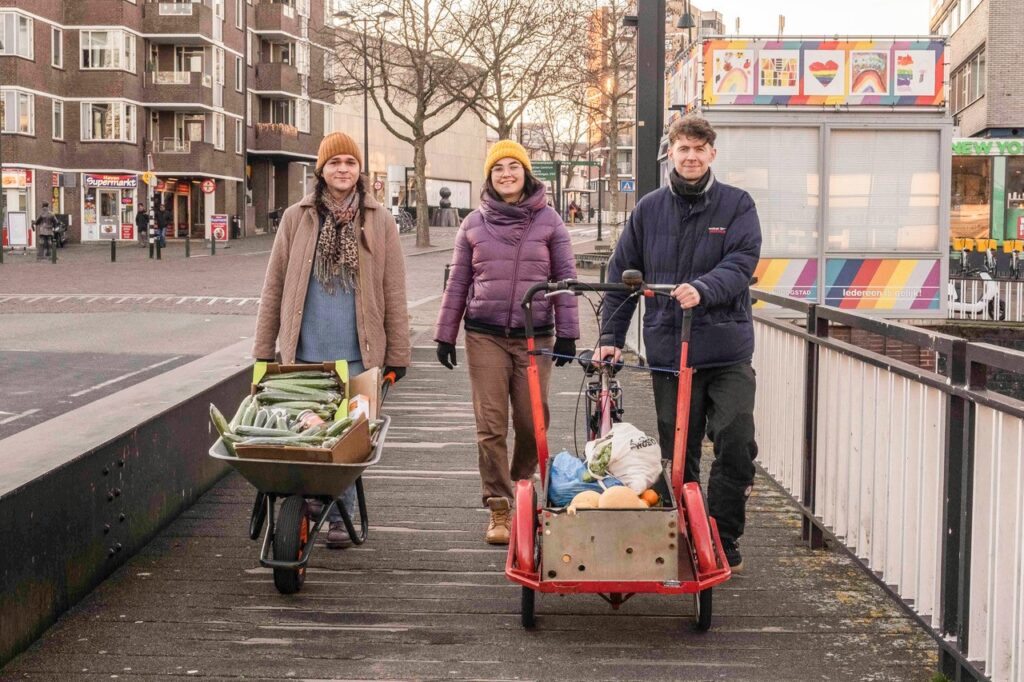The articles on this page were published in Dutch in the printed De Stoker magazine in July 2023. Here you can find most of the articles from that Stoker, translated in English.
Welcome dear reader. We hereby present the sixth edition of De Stoker, the in-house newspaper of Stad in de Maak.
This edition is about the Vlaardingen Commons, a project by Stad in de Maak in the Oostwijk neighborhood in Vlaardingen. Since April 2021, Stad in de Maak has been managing two streets, owned by housing cooperation ‘Samenwerking’: the Cornelis Houtmanstraat and the Nieuwe Kerkstraat. In total, the project consists of 65 homes and the gardens form three large communal areas. Most homes are inhabited. Technically uninhabitable houses are used for all kinds of collective facilities such as a workshop, kitchen and laundry.
The homes are listed for demolition. Until then, the original Vlaardingen residents from the streets and the new residents will form a community via Stad in de Maak. In this newspaper, compiled and written by the residents, you get an insight into various aspects of the community.
Local residents and interested people are always welcome to drop by. The door is usually open or else you can have a chat in the communal garden.
We wish you a lot of reading pleasure!
You will find the Dutch edition of the Stoker on the website of Stad in de Maak (www.stadindemaak.nl) or printed on the locations of Stad in de Maak projects.
This is how we organize ourselves
By Noemi Bardas
“Wouldn’t it be great if we could live somewhere cheap, where we are friends with our neighbours and actually have a say about what’s happening in our neighbourhood?”
Beginning of 2021, in and out of waves of lock-down, Romy and I were both desperately searching for a fresh start and a new living situation. Living alone in a neighbourhood of strangers, in the house of a landlord that sees inhabitants as capital felt lonely, frustrating and fragile. We were deeply longing to live in a way that was more connected to our values. “Wouldn’t it be great if we could live somewhere cheap, where we are friends with our neighbours and actually have a say about what’s happening in our neighbourhood?”, we said to each other.
That’s how in May 2021 we ended up in Vlaardingen – of all places! Together with nine others – strangers at the time – we took on the challenge to create a self-organized community in a neighbourhood with a tough reputation and crappy houses. After a few months and many more floor tiles, paint buckets, dinners and bottles of beer later, we finally felt like a tight knit group. Together with 20 more community members who joined along the way, we were ready to get organized.
Circles
There were lots of dreams sparkling in everyone’s eyes, but no concrete plans. How were we going to bring them all into practice? We started with two a weekend of creative brainstorming. This was meant to support us in connecting to each other, in explicitly defining common ground with regards to our dreams and needs around the community, and in making first steps towards translating these into practice.
We found out what is important for us as a group. We laid our dreams on the floor, stuck them to the walls, hung them in the air. Then, we identified the tasks and responsibilities necessary to sustain the community we dreamt of. We want to eat out of our own gardens? Well, then we need to dig. We want a fireplace? We need to build it. Based on these tasks and responsibilities we started shaping a structure together. The final outcome was creating several working groups which we called ‘circles’ and splitting ourselves amongst these groups.
Since we work without a hierarchy, there is no one person who manages everything, but we split the responsibilities and power throughout the group. This is why the circles are useful. Not everyone is involved in all decisions, but they are carried by smaller groups. This requires us to trust each other. Thus, I did not decide what will be planted in the garden, but I was very happy with all the pumpkins I ate last autumn.
Consent
An important characteristic of being a self-organized (housing) community is being able to decide ourselves, together what happens in our neighbourhood. This, in turn, raises the question of how we make decisions as a group without a hierarchy. We believe that a consent-based process fits best to our values and vision of autonomous self-determination and collaboration.
How it works is that everyone who is involved in making a decision has to agree with the solution. This is different from majority voting, where the outcome is determined by the preference of the majority. It is important for us that one should give their consent to an idea with generosity. Thus, not only if it is their ideal option, but if it is something they can be ok with, can work with. I’m not the biggest fan of puzzles, but some of my neighbours were excited about using one of common rooms as a community puzzle and boardgame space. Sure, why not!
On the other hand, if someone has a strong objection, a concern they cannot compromise on, we welcome it. In that case, they must contribute to improving the solution so that it also meets their needs. In this way we take responsibility for our objections and the solution becomes stronger. Parties, for example, have historically been a point of disagreement in the community. They stir enthusiasm as well as frustration. Yes, we need to celebrate together and yes, we also need to wake up early for work. So we adapt. Silent disco? External location? Day-time party? We figure it out.
General meeting
The structure we create is meant to support us to work together, organize, define, learn and change. One of the elements that enables this is the general meeting. We implemented the general meeting at the beginning of the project, in May 2021, and it continues to this day. This is a gathering meant to bring together the whole community to discuss organizational matters that concern us all and take decisions on these overarching topics. This can be lighter topics such as which day the community dinner should be or more serious concerns like problematic neighbours.
The meeting is open to anyone who wants to join based on the topics shared in advance. However, not everyone finds a meeting like this a personally fitting way to participate in the community. It is a constant process of figuring out a way of functioning that can be accessible and inclusive, as well as effective in decision-making,
Community day
At the beginning of 2022 Romy and I sensed a significant need for more connection in the community. The constitution of the group had changed and grown in number and we did not know each other well enough anymore to be able to collaborate effectively. A self-organized community is built upon strong interpersonal relationships. We need to be able to trust each other. This is a process that takes time and effort. To give it a boost we organized a full day to come together and celebrate. There was a music session, a cooking session, a mural painting session, a blacksmithing session and a face-painting session – all done by community members, because collaboration and ownership are foundational parts of our community values. Some of us cooked delicious food and there was of course a lot of gezelligheid. Most importantly, we really felt part of a greater group, of a community.
Of course, one event is only a step in the process. But together with the spring air bringing everyone to the streets and the gardens, the community started blooming – everyone seemed to be out and about, building, sowing, chatting, working together. Now the community day is a recurring event which we organize twice a year, with a program filled by community members.
Conclusion
Two years later, in a community of now about 70 people, I’ve learned a lot. We all have!
We’ve learned patience – collective and self-organized processes take time and they never go as your initial plan.
We’ve learned acceptance – everyone contributes differently and at their own pace, nobody should be forced to participate.
We’ve learned about diversity – to tap into the wisdom of the collective, we need to trust perspectives different than our own.
We’ve learned boundaries – finding the balance between personal space and communal participation.
We’ve learned the value of conflict – that is where the possibility of growth lies.
I see the value of living in a community as two-fold. Firstly, on a personal level, I live with people who care for me, trust me and know me as I am. This has a tremendously positive impact on my mental and physical wellbeing. It makes me happy! Secondly, I see how community living is part of a more just and sustainable society. Enabling people’s decision-making power over their living environment makes for more resilient neighbourhoods – more affordable, safer, where we can realize our needs and dreams, and most importantly, which feel like home.
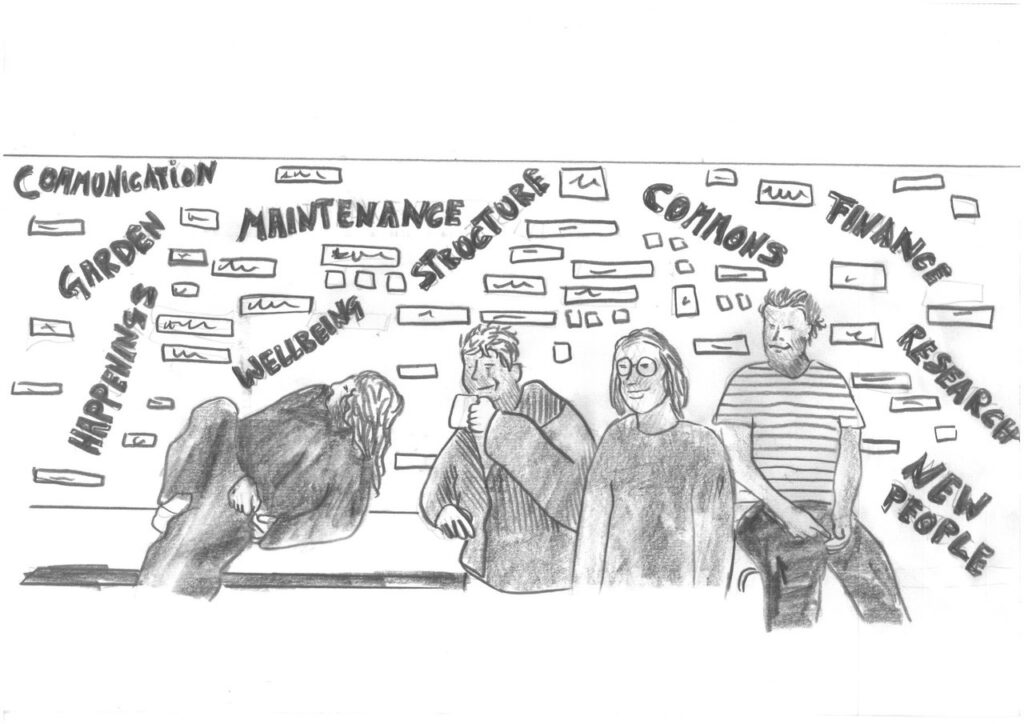
Residents of the Vlaardingen Commons
By Romy van Eeren
Josine (Artist)
Josine is full of stories about her adventures, she tells how her bike ride to the Black Sea finally landed her in Vlaardingen Commons. It takes some time to get used to a permanent place if you come from a nomadic existence. At first, she couldn’t quite find her way. ‘My life was mainly in Rotterdam’. She decided to go on an adventure again on a cycling holiday through Vietnam. Her return gave her a new perspective on the city and the community. ‘There is an informal and friendly atmosphere here, there is always something to do or someone you can tell your story to’.
Pim (Teacher)
Our musical talent Pim has lived here for four years now, so he knows how the neighborhood has changed in recent years. It was trouble from the start, he says. Behind every front door there was a problem of its own, which was often a combination of unfortunate events that resulted in a hopeless future. These unrests regularly lead to outbursts, which made the visit of the police a common happening. ‘The community should improve this, which was also exciting for us’, Pim said. ‘In the beginning, people were afraid of losing their homes’. In the end, it turned out to be a positive change that created peace in the street. ‘It’s a nice thought that you know who your neighbors are’.
Julia (Designer)
While Julia, pronounced ‘Goelia’, tells us how she ended up here, we are amazed. The walls serve as an exhibition of her art. She really liked living here. In addition to being close to good friend Clara, she finally had her own place. ‘It’s a nice combination of living on your own but not being alone in it. There is always someone in for a coffee, a walk or of course just a chat. We regularly eat together, watch a film or make a fire in the garden’.
Laura (Customer service employee)
Laura is one of the community’s first residents. Soon we talk about the element together, which is a crucial part here. We live here together, we do a lot together, we also share everything, such as spaces, tools, the washing machines, we even find solutions together. For example, Laura tells us that as a community we think it is important that everyone lives comfortably, if this turns out differently, we will try to solve this together. It’s a good idea that there are always people to fall back on, no matter what the challenge is.
Eugene (Driving instructor)
Pigeon fancier Eugene has been living here for a while. He says that it was a bit of a wait and see at first, but he soon noticed that the community created a friendly atmosphere in the street. ‘It’s just like old times’, he says. ‘You know who lives where, you are in contact with each other, occasionally we celebrate together, but at the same time nothing is obligatory’. Together with his wife Xenia and daughter Mileny they enjoy living here. Unfortunately, it doesn’t last forever, because the project will end soon. As a result, the residents here are left without a home, many of whom do not know what to expect.
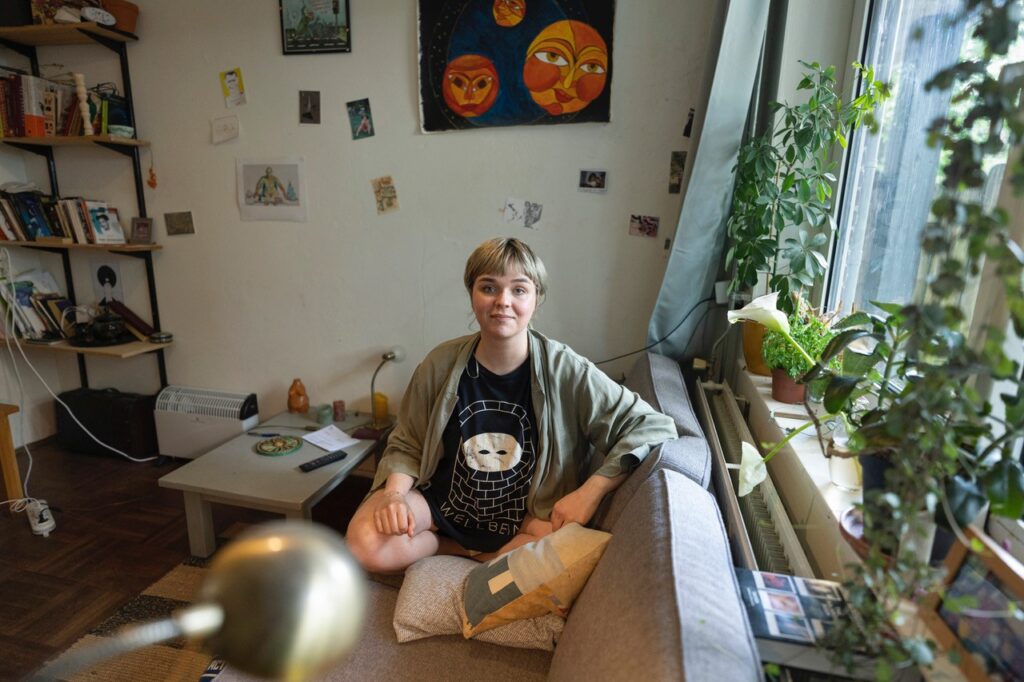
A community is moving in
By Clara Harmssen
Vlaardingen Commons started in two streets that were already home to people who initially didn’t choose to move to the community but chose to stay with the project.
How did the transition towards a community feel like to them?
The first impressions could not lie further apart from each other: “Weird new rules, without consultation with the current residents.” And: “The first residents from the community who came to live here were young, enthusiastic and very friendly. So my first experiences with these people were very positive.”
As someone who moved here right in the beginning of the project, I could feel the excitement and concerns that were voiced by the initial residents. A lot of changes came towards them. Their former contract was going to end as ‘Samenwerking’ decided to give the responsibility of the houses into the hands of Stad in de Maak. Now the residents were able to stay living here with the community project which could temporarily continue a while longer. But who wouldn’t when looking at the current housing crisis?
A new project was initiated, and no one knew how challenging it would be to communicate the vague concept of a ‘self-organized community’. Enthusiasm, unanswered questions, concerns and experimentation were the driving forces of the first few months.
After two years since the beginning of the project, I asked two of the residents, Mandy and Pim, to reflect back on the time living here as part of the community. One of the most significant and positive changes was that the street became a safer place. We were told that before there wasn’t a week without the police coming because of some incident that happened. ‘I think it’s great that people look out for each other and take care of each other’, Pim says. ‘You start to get to know your neighbours and be there for each other.’
Mandy says: ‘The moment I was invited to a housewarming, I finally felt I belonged somewhere.’
At the same time, it can be very difficult to be a part of it all, one of the former residents confided in me: ‘There is a strong core group here that is difficult to step into. Additionally, the regular community get togethers can cause the piling of noise in the streets and gardens’. Pim thinks that we, as a community, have to be a little careful about making noise in the late evening hours, to maintain the goodwill of the surrounding residents.
There is a lot that we can still learn from each other and try to figure out together. For all of us it is the first time building such a big temporary community project and that with more than 70 residents. Finally, I ask Pim if there is anything he takes with him from this project: ‘I hope some good friendships’.
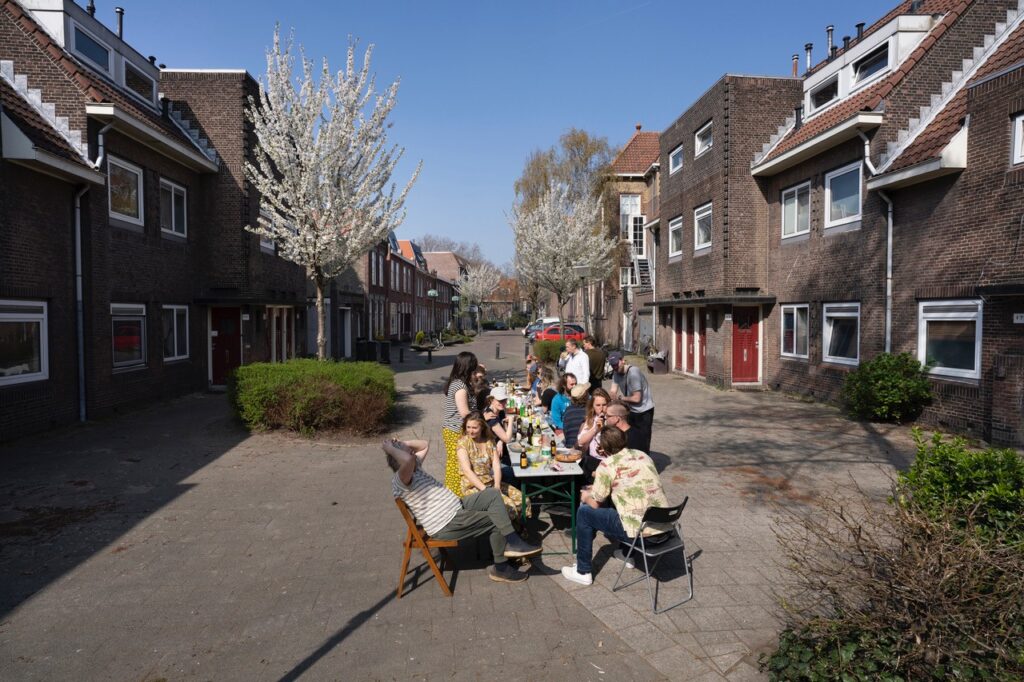
It’s ‘Happening’!
By Clara Harmssen
There was a Hostel Grand Opening of a now non-existing hostel and the much used and beloved common spaces designed by Studio CARE with help from students of the Rietveld Academy. The first Community dinners with many to come and a Neighbourhood day where we got to know a few neighbours that used to live in the street of which one of them lived there 76 years ago. A Winter street feast was organised where there was Glühwein served on the street, live concerts were happening in the swap shop, the old hostel was redesigned into an art gallery, here and there people were running around playing capture the flag, and everything ended with a big delicious feast and a DJ. On the Permablitz the whole garden was transformed in one day, sheds were taken down, wood chip paths were created, and we all ended up around the improved fire pit. And not to forget the Come together party, Valentines Chill, Jump in Spring, Karaoke party and Koningsdag market initiated by Mandy, one of our residents. And there were many more small spontaneous events happening in between.
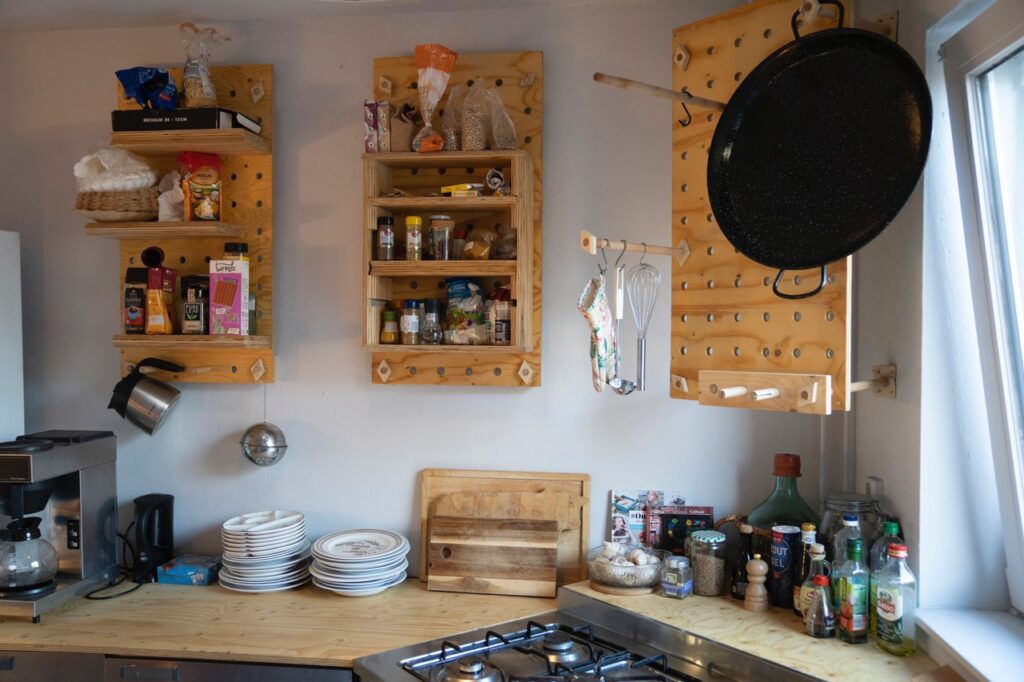
Commons
The commons (shared spaces and facilities) in Cornelis Houtmanstraat (CH) and Nieuwe Kerkstraat (NK) are well used by the community. Studio C.A.R.E. designed and realized most of these. The design duo took into account that the spaces remained flexible for the residents’ own interpretation. And it worked! The Swapshop was previously a music stage and the exercise room a cinema.
Laundry room
CH43
Here are two washing machines where residents can do their laundry. Occasionally, photos of lost socks are shared in the group chat.
Swap shop
CH43
With this swap shop nearby, you never have to go to a clothing store again. The idea is that you exchange clothes, but there are already so many that you can also only take them with you.
The space is large, which means that other activities or meetings occasionally take place between the clothing racks.
Movement space
CH22
Residents regularly enter CH22 to go through the two open walls to the house with the communal movement space. Here they follow a yoga session via YouTube or do a workout with fellow residents. Dance and movement workshops are also given by residents for residents.
The kitchen
CH22
The beating heart of the community is the kitchen. Every Wednesday evening, the No Waste Dinners are cooked here. The design by Studio C.A.R.E. is slowly being taken over by the household of the residents: there are notes everywhere with instructions for use or where to find ingredients. There is a long balcony on the three common houses: for the summer evenings.
Library
CH22
The wood chip floor of the library turned out to be used by cats as a litter box. Now that the shreds are gone, it is again a wonderful place to read a book.
The workplace
NK44
With so many users of one workshop, the hammers and nails are sometimes hard to find, but actually everything is there! You can go here to borrow a simple drilling machine, or you can carry out an ambitious construction project. Not sure how a device works? There are always people who come to help you. Many practical structures in the gardens and houses have been created here.
Co-working space
CH22
The base of the general meeting. A circle of chairs and a large chalkboard provide space for residents’ ideas and discussions.
Copy Shop
CH22
Residents can print and scan here. In the room you will find many types of paper, cutting mats and other supplies. Community activity posts and flyers can be printed here.
The gardens
Three large garden areas can be found in the two streets. Behind the Nieuwe Kerkstraat you will find the gardens with the greenhouse (residents call this garden the ‘West Hills’). Between the two streets is the largest area of green (‘Central Park’). Here is a campfire spot and space to get together.
The part behind the Cornelis Houtmanstraat is still divided into individual gardens. The idea of the community is that the fences and sheds are removed. This creates one large communal garden that everyone can use.

No Waste Dinners at Vlaardinger Meent
By Issy Baylis
Every Wednesday there is a free plant-based dinner in the communal kitchen of Cornelis Houtmanstraat 22 for everyone who wants to join us, local residents or not. Think of beers on the balcony, stew, curry, soup. It’s a weekly opportunity to get together and chat about our day, exchange recipes, and fight food waste at the same time. (Did you know that an average of 34 kg of food is wasted per person per year in the Netherlands? In total, that is 590 million kg of good food.)
We try to cook with food from the market and the organic store, but we don’t always make it in time to collect a wheelbarrow full of leftover vegetables.
Residents who regularly attend the dinner say it is very relaxed, even “the backbone of our community”. We take care of each other with food and good company. Everyone has to eat! This makes it very attractive and accessible: ‘even if I’ve had a long working day, sitting at the table with a group of more than ten neighbors feels like a shot of energy’.
When the clock strikes dinner time and bellies get hungry, people spontaneously come to help cook. A new system that we are now testing is ‘passing the hat’ to a volunteer. During dinner we decide who is responsible for coordinating a team for the following week. This way we bring more structure and there are always enough helping hands.
See you next Wednesday at 8 p.m.!
